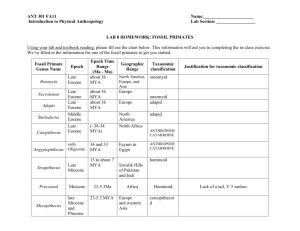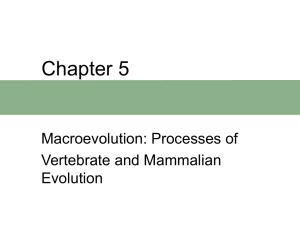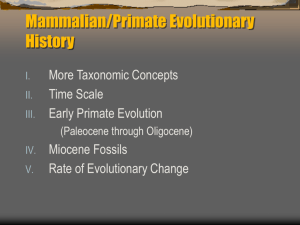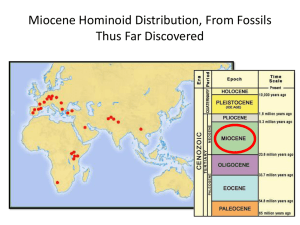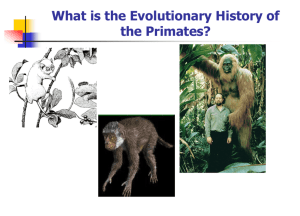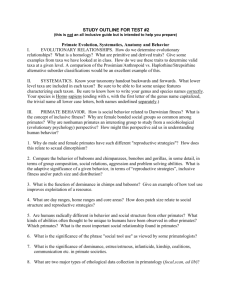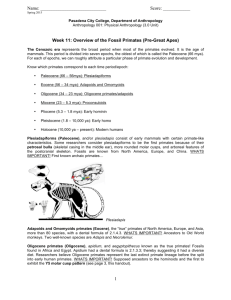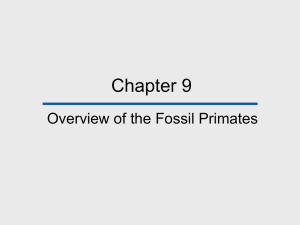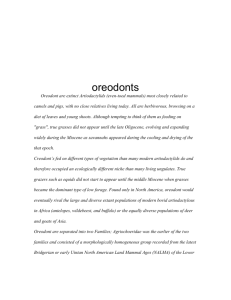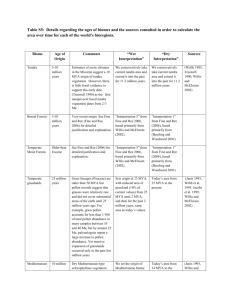Chapter 8
advertisement
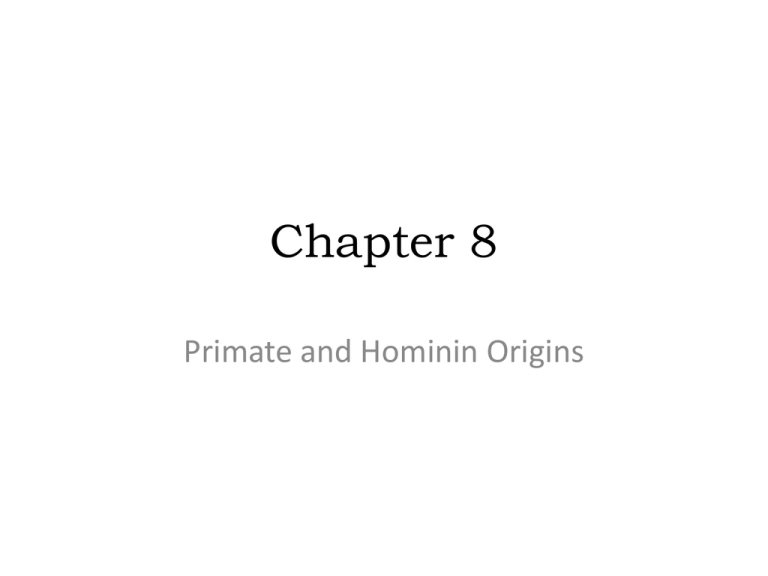
Chapter 8 Primate and Hominin Origins Ancestor to Primates? • What is ancestral to all the critters under the Order Primates? • Where all the humans, australopithicines, monkeys, apes, homo habilis, tarsiers, lorises, aye-ayes, Neandertals, etc. came from… Primates Review Me too! *Go back to the chart on pg. 129 The end of the Cretaceous period 65.5 mya • Millions of years ago right after the dinosaurs died… Paleocene 65 mya Placental mammal radiation • Earliest primates Eocene 55-35mya • More than 200 recognized fossil primate species. Eocene 55-35 mya • More than 200 recognized fossil species. Darwinius, from the Messel site in Germany, discovered in 2009 and dates to ~47 mya. Eocene Primates • Foramen magnum position = whether the body is habitually horizontal (like a horse) or vertical (like a monkey). • During the Eocene, the foramen magnum in some primate species was beginning to move from the back of the skull towards the center. • Suggesting…Holding their bodies erect while hopping and sitting, like modern lemurs, galagos, and tarsiers. Eocene Era primate and modern human skulls Oligocene • “Rafting” Africa-> South America ~34 mya early in the Oligocene • By this early point in the Oligocene, continental drift had separated the New World from the Old World. • New and Old World monkeys branch off here, 35 million years ago. Oligocene • Approximate position of the continents during the beginning of the Oligocene Oligocene Primates from Fayum • Apidium – Primitive dental arrangement suggests near or before evolutionary divergence of Old and New World anthropoids – Small, squirrel-like fruit and seed eating, adept at leaping and springing Walking with the Beasts (BBC) “Whale Killer” Egypt’s Fayum • Today, it’s a ~550 square mile lush “oasis” basin in the desert south of Cairo • During the Eocene and Oligocene, the Faiyum was forrested • At the beginning of the Miocene, the Faiyum had become a dry hollow Oligocene Primates from Fayum cont. • Aegyptopithecus (genus) – 35-33 mya – Largest of Fayum anthropoids, roughly the size of a modern howler monkey (13-18 lbs) – Short-limbed, slowmoving Miocene Hominoid Distribution, From Fossils Thus Far Discovered Miocene Hominoid Fossils 1. These hominoids are more closely related to the ape-human lineage than Old World monkeys. 2. Mostly large-bodied hominoids, more akin to the lineages of orangutans, gorillas, chimpanzees, and humans. 3. Most of the Miocene forms discovered are so derived that they are probably not ancestral to any living form. Miocene Fossil Hominoids African forms (23–14 mya) – Especially from western Kenya, these hominoids are, in many ways, primitive. – Proconsul Miocene Fossil Hominoids European forms (16–11 mya) – From scattered localities in France, Spain, Italy, Greece, Austria, Germany, and Hungary, most are quite derived. – Dryopithecus and Ouranopithecus Miocene Fossil Hominoids Asian forms (16–7 mya) – The largest and most varied group from Turkey through India/Pakistan and east to southern China, most are highly derived. – Sivapithecus Sivapithicus Sivapithecus (from Turkey and Pakistan) shows facial features similar to the modern orangutan, suggesting a fairly close evolutionary link. • Note the dished face, broad cheekbones, and projecting upper jaw and incisors on both Sivapithecus (left) and the Orangutan (right)
